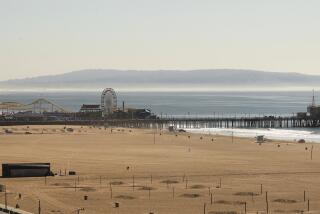Dissenters Fail to Put Brake on Bike Route Plan : Transportation: Is a proposed citywide bicycle master plan visionary or folly? It depends on whom you ask.
- Share via
SANTA MONICA — Despite pleas not to meddle in quiet residential areas, the Santa Monica City Council on Tuesday voted 5 to 1 to move forward with a pared-down version of a citywide bicycle master plan.
City Councilman Herb Katz was the lone dissenter, saying the plan is mediocre and the public is clearly not interested. The proposal should be nipped in the bud, Katz said, rather than taking it to the next step by preparing an environmental impact report.
The $2-million bicycle master plan involves a network of connecting bike routes and two bicycle boulevards, Washington Avenue and Pearl Street, which would be closed to through traffic. Several other proposed bicycle boulevards were dropped from the plan because of stiff neighborhood opposition.
Opposition to the remainder of the still-ambitious proposal was in evidence at the council meeting, as 68 speakers signed up to express their opinions, most of them negative.
Although proponents called it visionary, a small step toward curbing lung-choking smog, a larger, louder group called it folly, a lame attempt to impinge on their quality of life.
“The neighborhood fabric is so tenuous now,” resident Mary Beth Elliott said. “It’s so wonderful. It doesn’t need improvement. You just have to leave it alone.”
Others questioned whether the staff had established a need for such a network, or whether it would turn out to be an expensive--and disruptive--white elephant.
“I don’t think this plan makes a bit of sense unless it materially increases bike ridership and decreases automobile traffic,” resident Jack Kennedy said.
A third line of attack centered on the expense of what some saw as an optional item in a time of serious budget shortfalls at all levels of government. “Fiscal responsibility has to start somewhere,” resident Floy Ware said.
Santa Monica Planning Director Paul Berlant assured the council that money for bike route improvements is available and is earmarked for that use only. For example, the city has $70,000 on hand to pay for the environmental impact report. That money could not, as many speakers suggested, be used for education or other priorities.
Berlant said the bicycle master plan is part of an effort to provide alternative transportation to commuters to meet regional air quality standards.
Using a Los Angeles County Transportation Commission formula, Berlant said 5,000 of the city’s 85,000 workers could be expected to commute on their bicycles.
Proponents of the plan lauded its potential to get people out of their cars. “We’re choking to death on automobile emissions,” resident Ken Breisch said.
“The city has to be visionary,” Maggie McOmie argued.
The bicycle master plan has been in the works for more than a year, but it exploded into public consciousness in February when more than 200 agitated residents turned up at a Planning Commission meeting to protest.
Many questioned the wisdom of attracting hordes of weekend riders from all over the region, envisioning another Venice Beach. They also decried a proposal to ban parking on one side of a few residential streets to make room for a bike lane.
Since then, the parking ban idea has been dropped, as has a proposed bicycle boulevard for Alta Avenue, north of Montana. Arizona and Ashland avenues and Yale Street have also been scuttled as bike boulevards, though all will be in the network, which includes everything from boulevards to bike lanes to signs alone.
Council members moved on Tuesday to address a key concern of some residents: removing part of the green median on 17th and 11th streets to make a bike lane. Berlant said no trees would be removed, but the trimming of even a few feet of median parkway is touchy in Santa Monica.
“It doesn’t make sense to me to take up green space to put asphalt down,” Councilwoman Judy Abdo said.
The two streets, along with 7th, were chosen as north-south bike arteries because they are not cut in two by the Santa Monica Freeway, said consultant Ryan Snyder, who was paid about $20,000 to map out the plan.
Snyder said those streets also have stop lights in place at major thoroughfares, which are essential to bike riders. Putting them in on alternate streets would cost $80,000 per intersection, Snyder said.
Although Snyder said straight routes encourage the most use by bike riders, the council insisted on studying whether adjacent streets, such as 16th and 10th, that would not need widening, could be used for part of the route.
More to Read
Sign up for Essential California
The most important California stories and recommendations in your inbox every morning.
You may occasionally receive promotional content from the Los Angeles Times.












